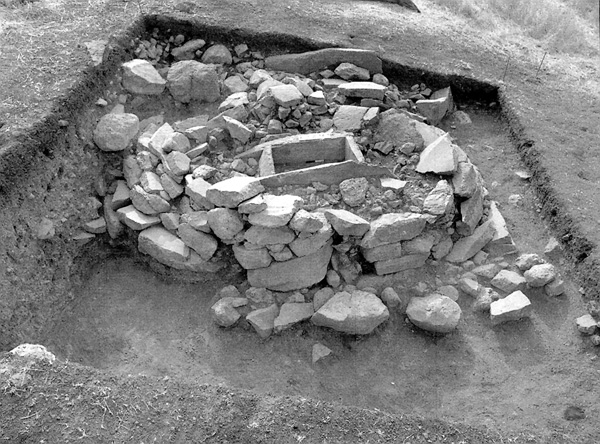Leviah Enclosure
EXCAVATION RESULTS
Seven brief excavation seasons were conducted in the Leviah Enclosure from 1987–1997. The excavations were directed by L. Vinitzky and Y. Paz, as part of the Land of Geshur Project, which is directed by P. Beck and M. Kochavi. Excavation results are being prepared for publication by Y. Paz, with guidance from M. Kochavi. The recent excavation seasons bore out the conclusions reached earlier in the excavation, while shedding light on certain issues. As elsewhere in the site, remains of the Early Bronze Age IB were found beneath the Early Bronze Age III structures. Only in area E, a new area opened between the inner and outer walls, were remains with characteristic Early Bronze Age II pottery found. The plans of the Early Bronze Age III structures in area B, west of the inner gate, were clarified. Most were single-room breithaus structures, though two have square rooms surrounding a courtyard; the largest structure was used for storing olive oil, next to which was found a stone-lined silo, 2 m in diameter. It became clear in the last season that the inner wall next to the inner gate (area A) is up to 10 m thick.
During the Israel Antiquities Authority Golan survey, a cemetery was discovered on a terrace on the southern slope of the spur upon which the site is built. Dozens of tombs were visible on the surface, three of which were excavated. One was a cist tomb, found without a cover and devoid of finds. The second was a tumulus that rose to a height of 1.5 m; two skeletons were found in the stone cist at its center. The third, another tumulus, contained two stone cists with skeletal remains and 12 complete pottery vessels, all dated to the Early Bronze Age IB.

It appears that the entire area of the site was settled during the course of the Early Bronze Age IB and that its inhabitants were buried in tumuli at the foot of the site. The eastern (“outer”) wall and the system of fortifications at the top of the slope were probably constructed during this period. In the Early Bronze Age II, the area of the settlement was limited to the eastern part of the site; the “inner wall” that protected the western side of the settlement was constructed in this period. In the Early Bronze Age III, the settlement again expanded over the entire surface of the site, the western wall became an inner wall, and a gate aligned with the central gate in the eastern wall was opened. The numerous reconstructable vessels in houses, indications of a conflagration, and many in-situ weapons in the main gate are evidence of a violent destruction of the site at the end of the third millennium BCE. Intermediate Bronze Age pottery found above the remains of the destroyed gates may attest to those responsible for this destruction. Settlement in the Leviah Enclosure was not renewed subsequently, although several stone fences and temporary shelters dated to the Middle Ages are extant at the site.
The Leviah Enclosure is the largest and only excavated site among the “Golan Enclosures.” It was a heavily fortified urban settlement with a highly developed system of agriculture, evidenced by its olive-oil processing installations. The settlement thrived on the Golan Heights for a millennium, until it met its demise in battle.
MOSHE KOCHAVI, YITZHAK PAZ
EXCAVATION RESULTS
Seven brief excavation seasons were conducted in the Leviah Enclosure from 1987–1997. The excavations were directed by L. Vinitzky and Y. Paz, as part of the Land of Geshur Project, which is directed by P. Beck and M. Kochavi. Excavation results are being prepared for publication by Y. Paz, with guidance from M. Kochavi. The recent excavation seasons bore out the conclusions reached earlier in the excavation, while shedding light on certain issues. As elsewhere in the site, remains of the Early Bronze Age IB were found beneath the Early Bronze Age III structures. Only in area E, a new area opened between the inner and outer walls, were remains with characteristic Early Bronze Age II pottery found. The plans of the Early Bronze Age III structures in area B, west of the inner gate, were clarified. Most were single-room breithaus structures, though two have square rooms surrounding a courtyard; the largest structure was used for storing olive oil, next to which was found a stone-lined silo, 2 m in diameter. It became clear in the last season that the inner wall next to the inner gate (area A) is up to 10 m thick.
During the Israel Antiquities Authority Golan survey, a cemetery was discovered on a terrace on the southern slope of the spur upon which the site is built. Dozens of tombs were visible on the surface, three of which were excavated. One was a cist tomb, found without a cover and devoid of finds. The second was a tumulus that rose to a height of 1.5 m; two skeletons were found in the stone cist at its center. The third, another tumulus, contained two stone cists with skeletal remains and 12 complete pottery vessels, all dated to the Early Bronze Age IB.
